Spatio-Temporal Dynamics, Driving Mechanisms, and Decoupling Evaluation of Farmland Carbon Emissions: A Case Study of Shandong Province, China
Abstract
1. Introduction
2. Materials and Methods
2.1. Study Area
2.2. Data Sources and Processing
2.3. Calculation of Carbon Emissions
2.3.1. Direct Carbon Emissions
2.3.2. Indirect Carbon Emissions
2.4. LMDI Model
2.5. Decoupling Model
3. Results
3.1. Farmland Carbon Emissions and Their Intensity in Shandong Province
3.2. Spatial Distribution of Carbon Emissions in Key Years Across Shandong’s Cities
3.3. Spatial Distribution of Carbon Emission Intensity in Key Years Across Shandong’s Cities
3.4. Factors Influencing Farmland Carbon Emissions in Shandong Province
3.5. Decoupling Analysis of Farmland Carbon Emissions and Economic Development in Shandong Province
4. Discussions
4.1. The Changes of Carbon Emissions in Shandong Province over the Years
4.2. Carbon Emission Factors and Their Relationship with Economic Development
4.3. Policy Implications
5. Conclusions
Author Contributions
Funding
Institutional Review Board Statement
Informed Consent Statement
Data Availability Statement
Conflicts of Interest
References
- Mora, C.; Spirandelli, D.; Franklin, E.C.; Lynham, J.; Kantar, M.B.; Miles, W.; Smith, C.Z.; Freel, K.; Moy, J.; Louis, L.V.; et al. Broad threat to humanity from cumulative climate hazards intensified by greenhouse gas emissions. Nat. Clim. Change 2018, 8, 1062–1071. [Google Scholar] [CrossRef]
- Wang, Y.; Guo, C.H.; Chen, X.J.; Jia, L.Q.; Guo, X.N.; Chen, R.S.; Zhang, M.S.; Chen, Z.Y.; Wang, H.D. Carbon peak and carbon neutrality in China: Goals, implementation path and prospects. China Geol. 2021, 4, 720–746. [Google Scholar] [CrossRef]
- Wijerathna Yapa, A.; Pathirana, R. Sustainable Agro-Food Systems for Addressing Climate Change and Food Security. Agriculture 2022, 12, 1554. [Google Scholar] [CrossRef]
- Nsabiyeze, A.; Ma, R.; Li, J.; Luo, H.; Zhao, Q.; Tomka, J.; Zhang, M. Tackling climate change in agriculture: A global evaluation of the effectiveness of carbon emission reduction policies. J. Clean. Prod. 2024, 468, 142973. [Google Scholar] [CrossRef]
- Forster, P.; Storelvmo, T.; Armour, K.; Collins, W.; Dufresne, J.L.; Frame, D.; Lunt, D.J.; Mauritsen, T.; Palmer, M.D.; Watanabe, M.; et al. The Earth’s Energy Budget, Climate Feedbacks, and Climate Sensitivity. In Climate Change 2021: The Physical Science Basis. Contribution of Working Group I to the Sixth Assessment Report of the Intergovernmental Panel on Climate Change; Masson-Delmotte, V., Zhai, P., Pirani, A., Connors, S.L., Péan, C., Berger, S., Caud, N., Chen, Y., Goldfarb, L., Gomis, M.I., et al., Eds.; Cambridge University Press: Cambridge, UK; New York, NY, USA, 2021; pp. 923–1054. [Google Scholar]
- Vermeulen, S.J.; Campbell, B.M.; Ingram, J.S.I. Climate change and food systems. Annu. Rev. Environ. Resour. 2012, 37, 195–222. [Google Scholar] [CrossRef]
- Ming, J.; Li, J.; Zhang, M. What drives the agricultural carbon emissions for low-carbon transition? Evidence from China. Environ. Impact Assess. Rev. 2024, 105, 107440. [Google Scholar] [CrossRef]
- Huang, X.; Xu, X.; Wang, Q.; Zhang, L.; Gao, X.; Chen, L. Assessment of Agricultural Carbon Emissions and Their Spatiotemporal Changes in China, 1997–2016. Int. J. Environ. Res. Public Health 2019, 16, 3105. [Google Scholar] [CrossRef]
- Tian, Y.; Zhang, J.; He, Y. Research on Spatial-Temporal Characteristics and Driving Factor of Agricultural Carbon Emissions in China. J. Integr. Agric. 2014, 13, 1393–1403. [Google Scholar] [CrossRef]
- Chen, Y.; Li, M.; Su, K.; Li, X. Spatial-temporal characteristics of the driving factors of agricultural carbon emissions: Empirical evidence from Fujian, China. Energies 2019, 12, 3102. [Google Scholar] [CrossRef]
- Vastola, A.; Viccaro, M.; Grippo, V.; Genovese, F.; Romano, S.; Cozzi, M. The Decoupling Effect in Italian Agricultural Waste: An Empirical Analysis. Sustainability 2023, 15, 16596. [Google Scholar] [CrossRef]
- Makutėnienė, D.; Perkumienė, D.; Makutėnas, V. Logarithmic mean Divisia index decomposition based on Kaya identity of GHG emissions from agricultural sector in Baltic States. Energies 2022, 15, 1195. [Google Scholar] [CrossRef]
- Han, G.; Xu, J.; Zhang, X.; Pan, X. Efficiency and Driving Factors of Agricultural Carbon Emissions: A Study in Chinese State Farms. Agriculture 2024, 14, 1454. [Google Scholar] [CrossRef]
- Shen, X.; Yan, R.; Jiang, M. How does planting structure change affect the agricultural net carbon sink? Evidence from the Jiangsu coastal economic Belt. Ecol. Indic. 2025, 170, 112949. [Google Scholar] [CrossRef]
- Tang, R.; Chu, Y.; Liu, X.; Yang, Z.; Yao, J. Driving Factors and Decoupling Effects of Non-CO2 Greenhouse Gas Emissions from Agriculture in Southwest China. Atmosphere 2024, 15, 1084. [Google Scholar] [CrossRef]
- Ang, B. LMDI decomposition approach: A guide for implementation. Energ. Policy 2015, 86, 233–238. [Google Scholar] [CrossRef]
- Yang, S.H.; Zhang, Y.Q.; Geng, Y. An LMDI-based investigation of the changes in carbon emissions of the transportation sector in the Yangtze River Economic Belt. China Environ. Sci. 2022, 10, 4817–4826. (In Chinese) [Google Scholar]
- Liu, Y.; Feng, C. What drives the decoupling between economic growth and energy-related CO2 emissions in China’s agricultural sector? Environ. Sci. Pollut. Res. 2021, 28, 44165–44182. [Google Scholar] [CrossRef]
- Lauk, C.; Magerl, A.; le Noë, J.; Theurl, M.C.; Gingrich, S. Analyzing long-term dynamics of agricultural greenhouse gas emissions in Austria, 1830–2018. Sci. Total Environ. 2024, 911, 168667. [Google Scholar] [CrossRef]
- Jia, L.; Wang, M.; Yang, S.; Zhang, F.; Wang, Y.; Li, P.; Ma, W.; Sui, S.; Liu, T.; Wang, M. Analysis of agricultural carbon emissions and carbon sinks in the Yellow River Basin based on LMDI and Tapio decoupling models. Sustain. For. 2024, 16, 468. [Google Scholar] [CrossRef]
- Yuan, R.; Xu, C.; Kong, F. Decoupling agriculture pollution and carbon reduction from economic growth in the Yangtze River Delta, China. PLoS ONE 2023, 18, e0280268. [Google Scholar] [CrossRef]
- De Freitas, L.C.; Kaneko, S. Decomposing the decoupling of CO2 emissions and economic growth in Brazil. Ecol. Econ. 2011, 70, 1459–1469. [Google Scholar] [CrossRef]
- Duan, Y.; Gao, Y.; Zhao, J.; Xue, Y.; Zhang, W.; Wu, W.; Jiang, H.; Cao, D. Agricultural methane emissions in China: Inventories, Driving Forces and Mitigation Strategies. Environ. Sci. Technol. 2023, 57, 13292–13303. [Google Scholar] [CrossRef] [PubMed]
- Zhang, L.; Chen, J.; Dinis, F.; Wei, S.; Cai, C. Decoupling effect, driving factors and prediction analysis of agricultural carbon emission reduction and product supply guarantee in China. Sustainability 2022, 14, 16725. [Google Scholar] [CrossRef]
- Meng, Y.; Shen, Y.; Wang, W.; Liu, Y.; Wang, F.; Wang, H. Who affects carbon emissions? Drivers and decoupling effects of agricultural carbon emissions—Evidence from Sichuan, China. Front. Sustain. Food Syst. 2024, 8, 1441118. [Google Scholar] [CrossRef]
- Jiang, J.; Zhao, T.; Wang, J. Decoupling analysis and scenario prediction of agricultural CO2 emissions: An empirical analysis of 30 provinces in China. J. Clean Prod. 2021, 320, 128798. [Google Scholar] [CrossRef]
- National Bureau of Statistics of China (NBSC). China Statistics Yearbook; China Statistics Press: Beijing, China, 2024. Available online: https://www.stats.gov.cn/sj/ndsj/ (accessed on 10 May 2025).
- Bureau of Statistics of Shandong Province. Shandong Statistical Yearbook; China Statistics Press: Beijing, China, 2005–2024. Available online: http://tjj.shandong.gov.cn/col/col6279/index.html (accessed on 12 May 2025).
- Bureau of Statistics of Shandong Province. Shandong Rural Statistical Yearbook; China Statistics Press: Beijing, China, 2005–2024. Available online: http://nync.shandong.gov.cn/zwgk/nytj/ (accessed on 15 May 2025).
- Wang, C.; Niu, J. Water and Carbon Footprint and Layout Optimization of Major Grain Crops in the Northwest China. Sci. Agric. Sin. 2024, 57, 1137–1152. (In Chinese) [Google Scholar]
- Li, W.; Ou, Q.; Chen, Y. Decomposition of China’s CO2 emissions from agriculture utilizing an improved Kaya identity. Environ. Sci. Pollut. Res. Int. 2014, 21, 13000–13006. [Google Scholar] [CrossRef]
- Xia, Q.; Liao, M.; Xie, X.; Guo, B.; Lu, X.; Qiu, H. Agricultural carbon emissions in Zhejiang Province, China (2001–2020): Changing Trends, Influencing Factors, and has it Achieved Synergy with Food Security and Economic Development? Environ Monit Assess. 2023, 195, 1391. [Google Scholar] [CrossRef]
- Liu, X.; Ye, Y.; Ge, D.; Wang, Z.; Liu, B. Study on the Evolution and Trends of Agricultural Carbon Emission Intensity and Agricultural Economic Development Levels—Evidence from Jiangxi Province. Sustainability 2022, 14, 14265. [Google Scholar] [CrossRef]
- Liu, Y.; Liu, H.B. Characteristics, influence factors, and prediction of agricultural carbon emissions in Shandong Province. Chin. J. Eco-Agric. 2022, 30, 558–569. (In Chinese) [Google Scholar]
- Wang, X.F. Since the Reform and Opening Up Agricultural Policy of the Communist Party of China; Shandong Normal University: Jinan, China, 2012. (In Chinese) [Google Scholar]
- Yang, B.J.; Tian, J.R.; Sun, H.Y. Study on the factors affecting the carbon footprint of agricultural production based on the SVAR model. Ecol. Econ. 2019, 35, 120–127. (In Chinese) [Google Scholar]
- Zhang, X.; Zhang, Y.; Fan, S. The multiple roles of crop structural change in productivity, nutrition and environment in China: A decomposition analysis. J. Integr. Agric. 2024, 23, 1763–1773. [Google Scholar] [CrossRef]
- Li, B.; Zhang, J.B.; Li, H.P. Research on spatial-temporal characteristics and affecting factors decomposition of agricultural carbon emission in China. China Popul. Resour. Environ. 2011, 21, 80–86. (In Chinese) [Google Scholar]
- Zhang, F.; Liu, F.; Ma, X.; Guo, G.; Liu, B.; Cheng, T.; Liang, T.; Tao, W.; Chen, X.; Wang, X. Greenhouse gas emissions from vegetables production in China. J. Clean. Prod. 2021, 317, 128449. [Google Scholar] [CrossRef]
- Li, N.; Wei, C.; Zhang, H.; Cai, C.; Song, M.; Miao, J. Drivers of the national and regional crop production-derived greenhouse gas emissions in China. J. Clean. Prod. 2020, 257, 120503. [Google Scholar] [CrossRef]
- Huang, X.; Wu, X.; Guo, X.; Shen, Y. Agricultural carbon emissions in China: Measurement, Spatiotemporal Evolution, and Influencing Factors Analysis. Front. Environ. Sci. 2024, 12, 1488047. [Google Scholar] [CrossRef]
- Zhu, Y.; Huo, C. The Impact of Agricultural Production Efficiency on Agricultural Carbon Emissions in China. Energies 2022, 15, 4464. [Google Scholar] [CrossRef]
- Hao, Y.; Zhang, Z.Y.; Yang, C.X.; Wu, H.T. Does structural labor change affect CO2 emissions? Theoretical and empirical evidence from China. Technol. Forecast. Soc. Change 2021, 171, 120936. [Google Scholar] [CrossRef]
- Huang, X.B.; Gao, S.Q. Temporal characteristics and influencing factors of agricultural carbon emission in Jiangxi province of China. Environ. Res. Commun. 2022, 4, 045006. [Google Scholar] [CrossRef]
- Zhang, Z.Y.; Hu, C.X.; Lian, G.; Yang, Y.Y. Evolution of the collaborative network of agricultural non-point source pollution control policies in China. J. Agric. Resour. Environ. 2025, 1–12. (In Chinese) [Google Scholar] [CrossRef]
- Geng, Y.; Wang, J.; Sun, Z.; Ji, C.; Huang, M.; Zhang, Y.; Xu, P.; Li, S.; Pawlett, M.; Zou, J. Soil N-oxide emissions decrease from intensive greenhouse vegetable fields by substituting synthetic N fertilizer with organic and bio-organic fertilizers. Geoderma 2021, 383, 114730. [Google Scholar] [CrossRef]
- Balafoutis, A.; Beck, B.; Fountas, S.; Vangeyte, J.; Van der Wal, T.; Soto, I.; Gómez-Barbero, M.; Barnes, A.; Eory, V. Precision agriculture technologies positively contributing to GHG emissions mitigation, farm productivity and economics. Sustainability 2017, 9, 1339. [Google Scholar] [CrossRef]
- McNunn, G.; Karlen, D.L.; Salas, W.; Rice, C.W.; Mueller, S.; Muth, D., Jr.; Seale, J.W. Climate smart agriculture opportunities for mitigating soil greenhouse gas emissions across the US Corn-Belt. J. Clean. Prod. 2020, 268, 122240. [Google Scholar] [CrossRef]
- Kabato, W.; Getnet, G.T.; Sinore, T.; Nemeth, A.; Molnár, Z. Towards climate-smart agriculture: Strategies for sustainable agricultural production, food security, and greenhouse gas reduction. Agronomy 2025, 15, 565. [Google Scholar] [CrossRef]
- Zhang, W.; Feng, J.; Bai, X.; He, W.; Mo, J.; Gao, Q.; Wang, K.; Gu, S. Crop yield and soil quality of soya bean-maize rotation in response to 8-year keep stubble with no tillage practices on the Northeast China. Eur. J. Agron. 2025, 164, 127526. [Google Scholar] [CrossRef]
- Mehran, M.; Huang, L.; Geng, M.; Gan, Y.; Cheng, J.; Zhu, Q.; Ahmad, I.A.; Haider, S.; Mustafa, A. Co-utilization of green manure with straw return enhances the stability of soil organic carbon by regulating iron-mediated stabilization of aggregate-associated organic carbon in paddy soil. Soil Till. Res. 2025, 252, 106624. [Google Scholar] [CrossRef]
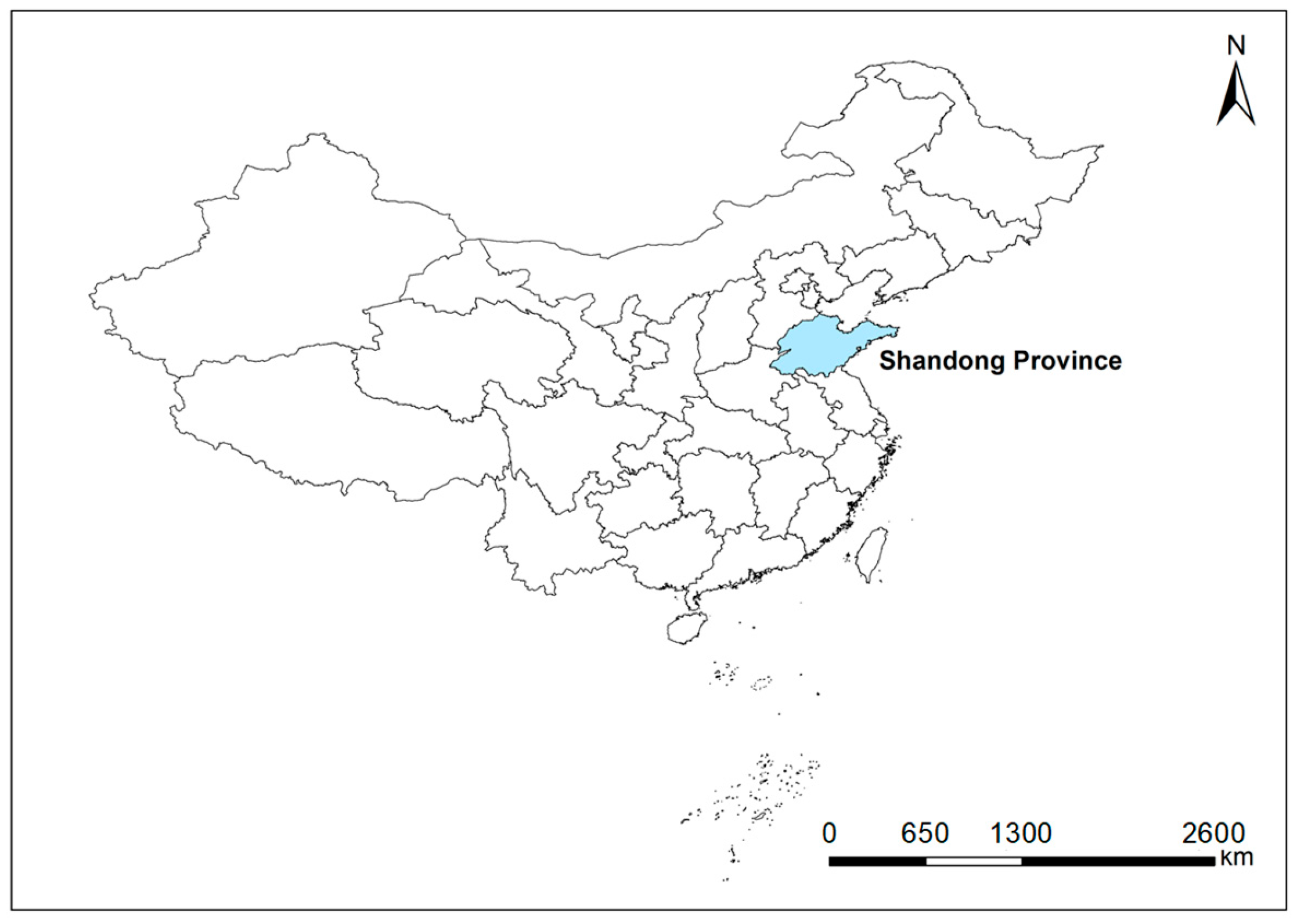
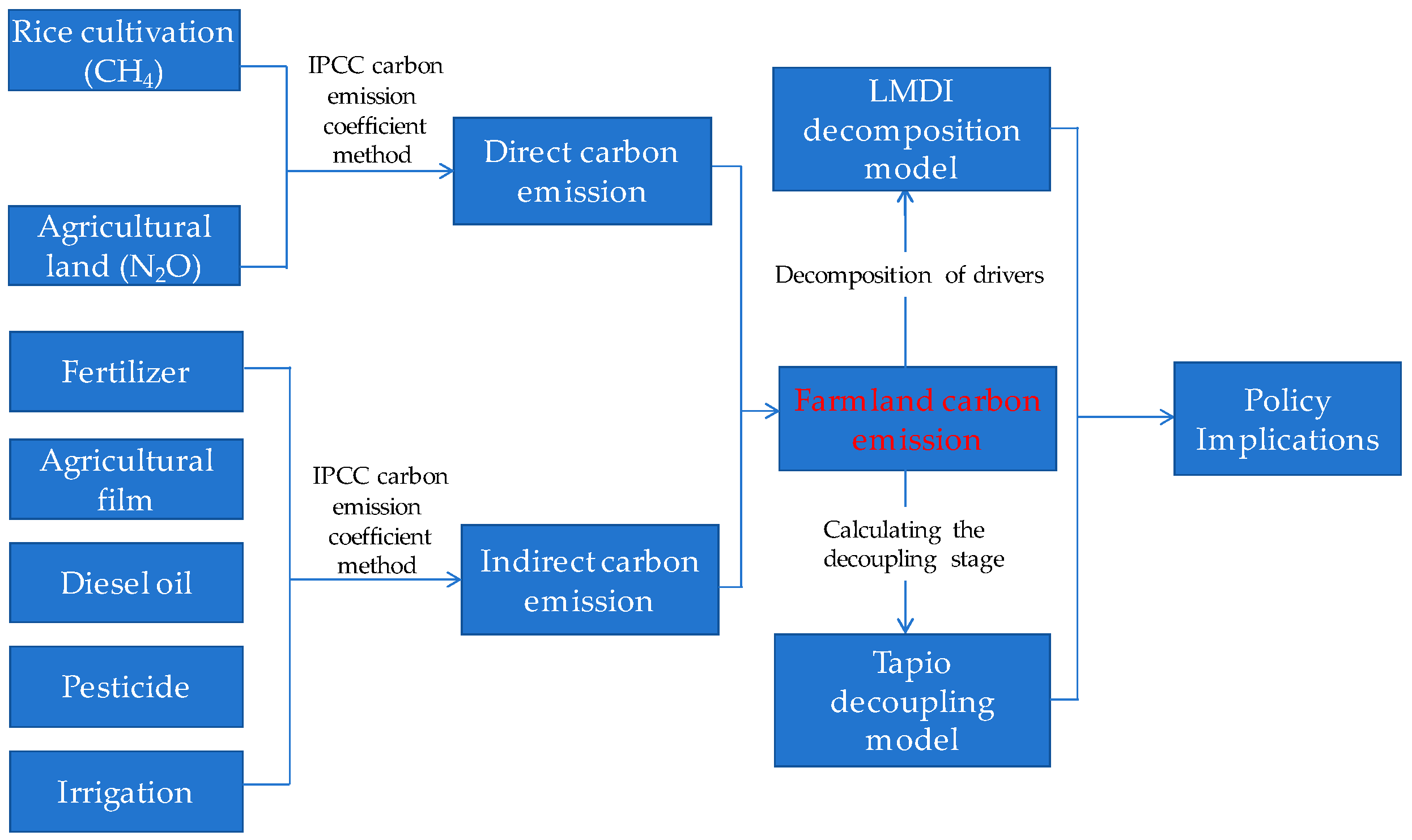
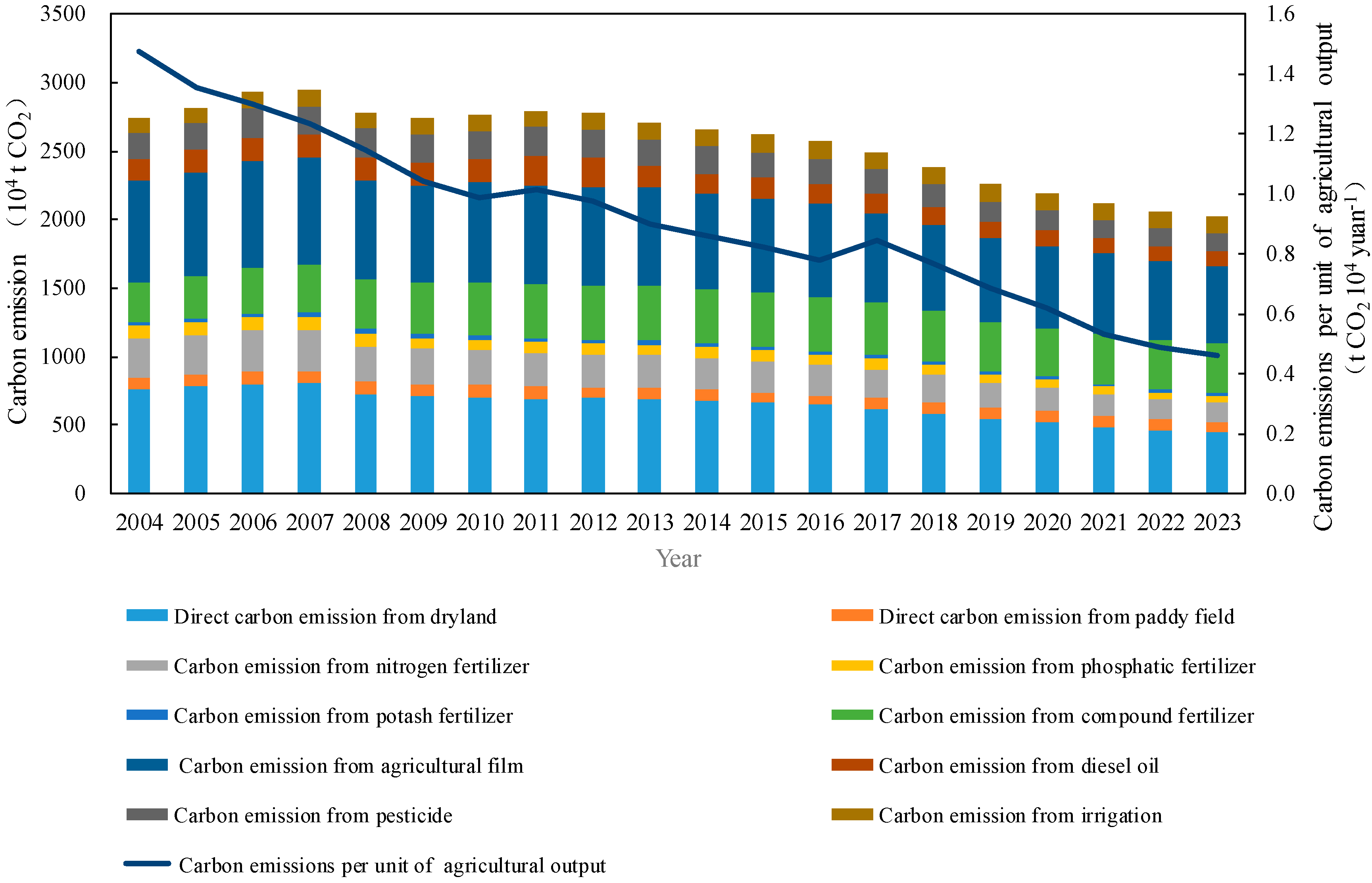
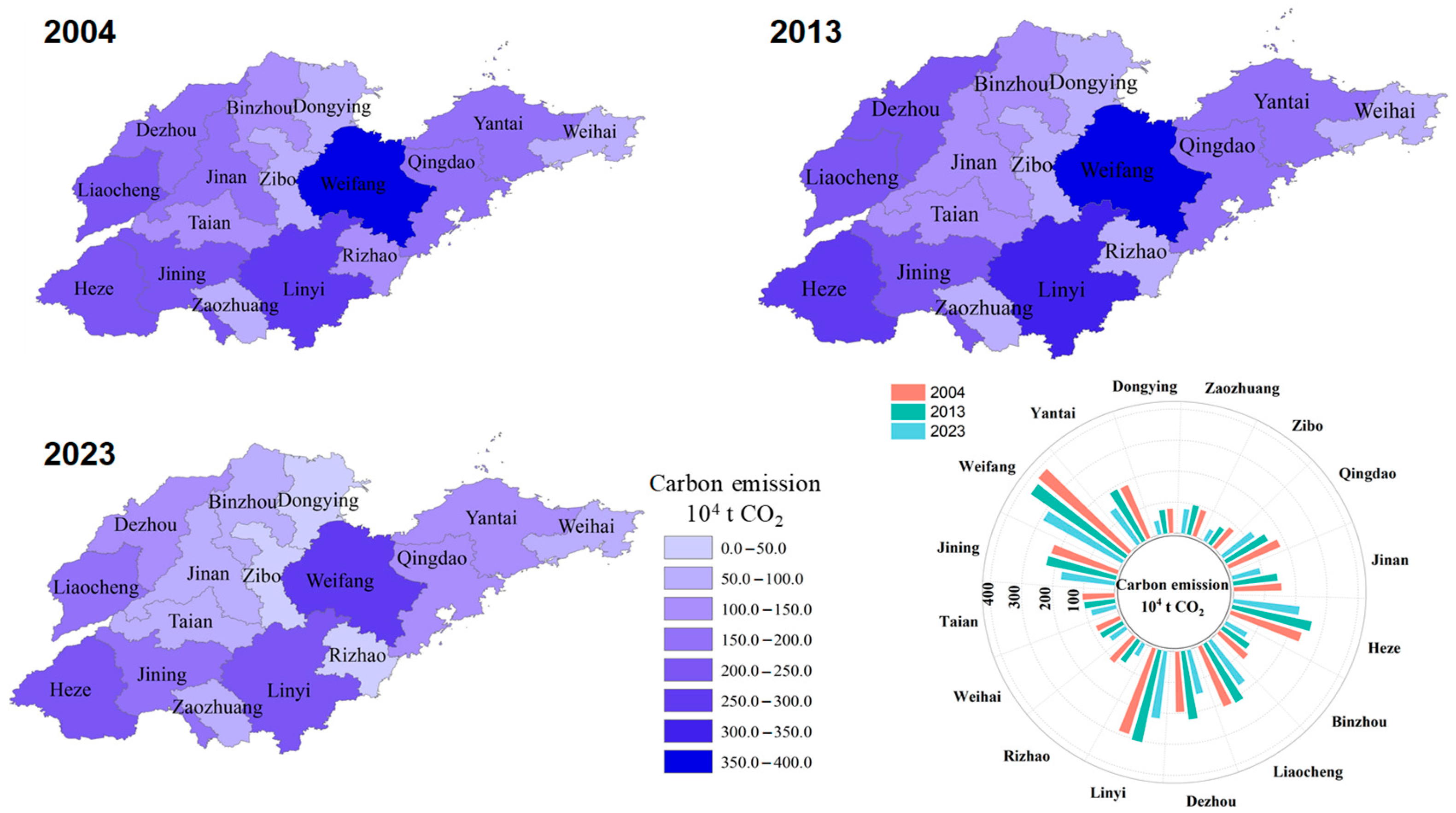
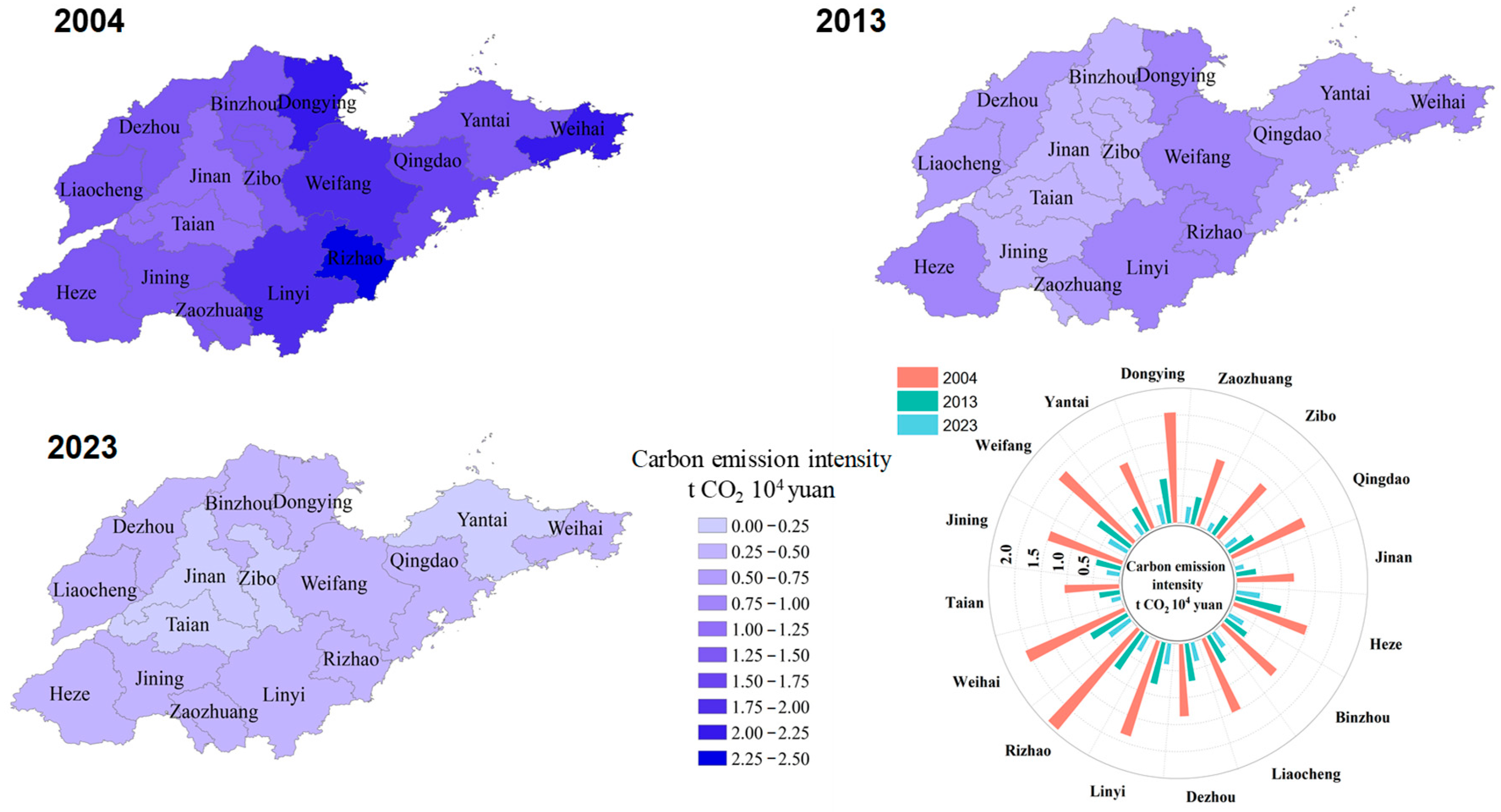

| States | Carbon Emission Growth Rate | Economic Growth Rate | Decoupling Elasticity (e) | |
|---|---|---|---|---|
| Decoupling | Weak decoupling | >0 | >0 | 0 ≤ e < 0.8 |
| Strong decoupling | <0 | >0 | e < 0 | |
| Recessive decoupling | <0 | <0 | e > 1.2 | |
| Connection | Growth connection | >0 | >0 | 0.8 ≤ e ≤ 1.2 |
| Fading connection | <0 | <0 | 0.8 ≤ e ≤ 1.2 | |
| Negative decoupling | Weak negative decoupling | <0 | <0 | 0 ≤ e ≤ 0.8 |
| Strong negative decoupling | >0 | <0 | e < 0 | |
| Expansive negative decoupling | >0 | >0 | e > 1.2 | |
| Region | Direct Carbon Emission (104 t CO2) | Indirect Carbon Emission (104 t CO2) | ||||
|---|---|---|---|---|---|---|
| 2004 | 2013 | 2023 | 2004 | 2013 | 2023 | |
| Jinan | 52.0 | 45.6 | 24.5 | 102.5 | 99.1 | 69.6 |
| Qingdao | 49.4 | 30.3 | 20.4 | 131.7 | 124.0 | 103.1 |
| Zibo | 20.7 | 14.9 | 9.8 | 63.9 | 52.7 | 33.2 |
| Zaozhuang | 30.0 | 34.0 | 24.3 | 59.4 | 63.9 | 56.5 |
| Dongying | 24.7 | 22.7 | 19.9 | 55.2 | 55.2 | 27.0 |
| Yantai | 56.5 | 50.3 | 37.8 | 130.1 | 139.0 | 102.6 |
| Weifang | 80.5 | 59.1 | 37.2 | 300.3 | 309.7 | 253.4 |
| Jining | 91.3 | 91.0 | 68.1 | 132.7 | 139.3 | 108.0 |
| Taian | 29.8 | 26.9 | 17.1 | 74.7 | 73.9 | 66.1 |
| Weihai | 21.0 | 14.9 | 11.9 | 63.1 | 66.5 | 50.3 |
| Rizhao | 29.4 | 19.3 | 9.4 | 78.4 | 66.9 | 37.3 |
| Linyi | 104.4 | 91.1 | 65.2 | 185.5 | 213.7 | 154.6 |
| Dezhou | 64.5 | 73.5 | 46.1 | 132.0 | 149.6 | 100.3 |
| Liaocheng | 67.0 | 67.5 | 44.0 | 145.3 | 150.2 | 130.7 |
| Binzhou | 37.6 | 33.7 | 22.0 | 82.0 | 70.2 | 56.7 |
| Heze | 89.4 | 95.5 | 67.4 | 150.1 | 166.6 | 148.1 |
| Total | 848.1 | 770.2 | 525.1 | 1887.0 | 1940.2 | 1497.5 |
| Year | ΔCI | ΔSI | ΔEI | ΔLI | ΔCtotal |
|---|---|---|---|---|---|
| 2004−2005 | −21.34 | 4.78 | 37.95 | 12.13 | 33.52 |
| 2005−2006 | −10.35 | −2.02 | 27.84 | −9.62 | 5.84 |
| 2006−2007 | −13.38 | −5.84 | 32.87 | −10.94 | 2.71 |
| 2007−2008 | −18.95 | −1.11 | 28.75 | −10.67 | −1.98 |
| 2008−2009 | −25.37 | 3.23 | 22.56 | −12.03 | −11.61 |
| 2009−2010 | −13.99 | −0.36 | 28.31 | −12.06 | 1.89 |
| 2010−2011 | 7.96 | −5.15 | 20.37 | −11.73 | 11.45 |
| 2011−2012 | −10.72 | −2.12 | 26.87 | −12.64 | 1.39 |
| 2012−2013 | −21.81 | 2.98 | 23.76 | −13.39 | −8.46 |
| 2013−2014 | −11.06 | 0.08 | 22.37 | −15.02 | −3.62 |
| 2014−2015 | −12.38 | 4.18 | 22.60 | −15.41 | −1.01 |
| 2015−2016 | −12.99 | −3.83 | 28.47 | −17.90 | −6.25 |
| 2016−2017 | 19.99 | −23.20 | 15.96 | −18.23 | −5.48 |
| 2017−2018 | −24.11 | 6.44 | 28.18 | −16.39 | −5.89 |
| 2018−2019 | −28.02 | −4.17 | 33.48 | −16.39 | −15.09 |
| 2019−2020 | −22.83 | −0.08 | 31.93 | −16.73 | −7.72 |
| 2020−2021 | −34.97 | 0.90 | 44.67 | −15.26 | −4.66 |
| 2021−2022 | −19.65 | 3.77 | 30.23 | −16.70 | −2.35 |
| 2022−2023 | −12.04 | 2.94 | 23.85 | −17.98 | −3.23 |
| Total | −286.03 | −18.57 | 531.00 | −246.96 | 33.52 |
| Region | 2004–2013 | 2014–2023 | ||||||
|---|---|---|---|---|---|---|---|---|
| ΔC/C | ΔGDP/GDP | e | Decoupling State | ΔC/C | ΔGDP/GDP | e | Decoupling State | |
| Jinan | −0.06 | 2.25 | −0.03 | Strong decoupling | −0.33 | 0.98 | −0.34 | Strong decoupling |
| Qingdao | −0.15 | 2.53 | −0.06 | Strong decoupling | −0.19 | 0.81 | −0.24 | Strong decoupling |
| Zibo | −0.20 | 2.31 | −0.09 | Strong decoupling | −0.31 | 0.13 | −2.35 | Strong decoupling |
| Zaozhuang | 0.09 | 2.59 | 0.04 | Weak decoupling | −0.18 | 0.09 | −1.99 | Strong decoupling |
| Dongying | −0.02 | 2.64 | −0.01 | Strong decoupling | −0.40 | 0.14 | −2.89 | Strong decoupling |
| Yantai | 0.01 | 2.44 | 0.01 | Weak decoupling | −0.25 | 0.69 | −0.36 | Strong decoupling |
| Weifang | −0.03 | 2.69 | −0.01 | Strong decoupling | −0.18 | 0.59 | −0.31 | Strong decoupling |
| Jining | 0.03 | 2.35 | 0.01 | Weak decoupling | −0.21 | 0.45 | −0.47 | Strong decoupling |
| Taian | −0.04 | 3.03 | −0.01 | Strong decoupling | −0.18 | 0.11 | −1.71 | Strong decoupling |
| Weihai | −0.03 | 1.66 | −0.02 | Strong decoupling | −0.21 | 0.26 | −0.79 | Strong decoupling |
| Rizhao | −0.20 | 3.26 | −0.06 | Strong decoupling | −0.45 | 0.48 | −0.92 | Strong decoupling |
| Linyi | 0.05 | 2.40 | 0.02 | Weak decoupling | −0.23 | 0.71 | −0.32 | Strong decoupling |
| Dezhou | 0.13 | 2.56 | 0.05 | Weak decoupling | −0.33 | 0.47 | −0.70 | Strong decoupling |
| Liaocheng | 0.03 | 3.28 | 0.01 | Weak decoupling | −0.20 | 0.16 | −1.24 | Strong decoupling |
| Binzhou | −0.13 | 3.06 | −0.04 | Strong decoupling | −0.28 | 0.37 | −0.77 | Strong decoupling |
| Heze | 0.09 | 4.53 | 0.02 | Weak decoupling | −0.17 | 1.01 | −0.17 | Strong decoupling |
Disclaimer/Publisher’s Note: The statements, opinions and data contained in all publications are solely those of the individual author(s) and contributor(s) and not of MDPI and/or the editor(s). MDPI and/or the editor(s) disclaim responsibility for any injury to people or property resulting from any ideas, methods, instructions or products referred to in the content. |
© 2025 by the authors. Licensee MDPI, Basel, Switzerland. This article is an open access article distributed under the terms and conditions of the Creative Commons Attribution (CC BY) license (https://creativecommons.org/licenses/by/4.0/).
Share and Cite
Sun, T.; Li, R.; Zhao, Z.; Guo, B.; Ma, M.; Yao, L.; Gao, X. Spatio-Temporal Dynamics, Driving Mechanisms, and Decoupling Evaluation of Farmland Carbon Emissions: A Case Study of Shandong Province, China. Sustainability 2025, 17, 6876. https://doi.org/10.3390/su17156876
Sun T, Li R, Zhao Z, Guo B, Ma M, Yao L, Gao X. Spatio-Temporal Dynamics, Driving Mechanisms, and Decoupling Evaluation of Farmland Carbon Emissions: A Case Study of Shandong Province, China. Sustainability. 2025; 17(15):6876. https://doi.org/10.3390/su17156876
Chicago/Turabian StyleSun, Tao, Ran Li, Zichao Zhao, Bing Guo, Meng Ma, Li Yao, and Xinhao Gao. 2025. "Spatio-Temporal Dynamics, Driving Mechanisms, and Decoupling Evaluation of Farmland Carbon Emissions: A Case Study of Shandong Province, China" Sustainability 17, no. 15: 6876. https://doi.org/10.3390/su17156876
APA StyleSun, T., Li, R., Zhao, Z., Guo, B., Ma, M., Yao, L., & Gao, X. (2025). Spatio-Temporal Dynamics, Driving Mechanisms, and Decoupling Evaluation of Farmland Carbon Emissions: A Case Study of Shandong Province, China. Sustainability, 17(15), 6876. https://doi.org/10.3390/su17156876








